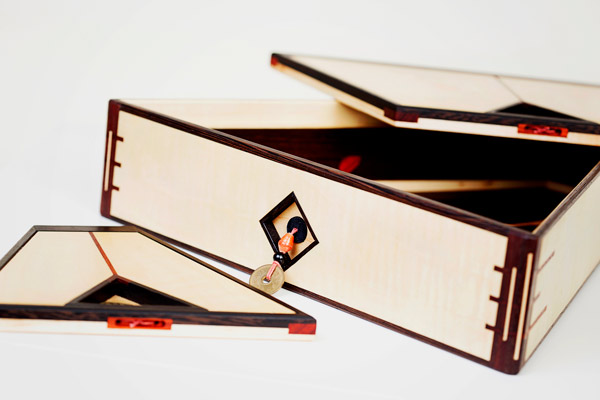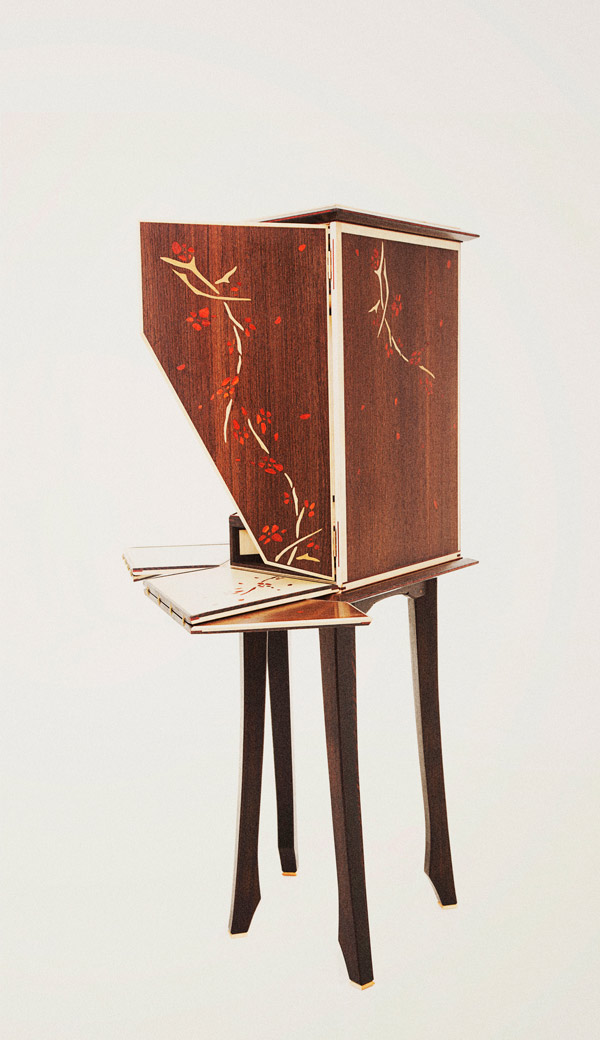Masterpiece Cabinets, Part 3

Above: Benjamin Reddan, Awakening of a Dream, 1580mm high x 850mm wide x 655mm deep, birch ply veneered and inlaid with quarter-cut wenge and fiddleback maple veneer; solid wenge, hard rock maple, American beech, padauk, jarrah, Tas oak, redgum, pine.
This is the last in a three-part feature that draws together the work of three makers who all live in Australia, but thousands of kilometres apart. Each has designed and crafted a cabinet of extraordinary merit that has recently received awards. What ties them together is the level of excellence, complexity and attention to fine detail their work presents. Each acknowledges the profound influence of the past makers, traditions and styles they have researched. While referencing the past each piece is an original design, created as a tribute to those traditions, and for the enjoyment of the technical challenges they presented. Here, Benjamin Reddan talks about his Ikebana cabinet.
Words: Benjamin Reddan
Photos: Kat Tramoy
Ikebana Cabinet
In June 2014 I completed both my Certificate III studies in cabinet and furniture making and an Associate Degree of Design (Furniture) at RMIT in Melbourne. The cabinet shown here was the last assessment for my apprenticeship. I entered it into the Australian Furniture Association awards and won the Cert III in cabinet furniture making apprentice of the year and also the main Andrew Kossenas Furnishing Apprentice of the Year Award.
Awakening of a Dream is a 360° viewing cabinet that can function as an ikebana (flower arrangement) or kodo (incense) cabinet.
There were many times I wanted to give up on this project but help from family, friends, co-workers, mentors and teachers pushed me on to completing it. Most of the processes and materials used were new to me. It has pushed me into the next chapter of growth by strengthening me through the challenges that were laid out before me. There are elements I could improve on, but to be honest I would not remake it again.

From the front, when open, the cabinet presents the Ikebana arrangement. Ikebana were originally presented in alcoves of walls in houses and only viewed, slightly offset, from the front. The cabinet contains slanted trapezium boxes that have lids. These can be taken out and used elsewhere.
I strongly believe that well made furniture has a soul. Every aspect of a piece of furniture, whether it’s a corner block, hinge or piece of inlay should be treated with the same respect as the other. Each piece an artist voyages through awakens the next stage of a life. I try to look at cabinet pieces as not just vessels to store trinkets and other items that express one’s journey in life, but as expressing ‘a world inside a world’. This idea is also drawn from the unique creations of father and son Abraham and David Roentgen who were master furniture makers from the 1700s to early 1800s.

I also used the design concept kukan/ supesu, ‘space is not empty’. The negative space in my final piece was expressed through the diamond cavity formed when the doors are closed and create a small ‘window into another world’. This space is also the initial opening point of the cabinet. Handles on the doors would have interfered with the inlay and I wanted a streamlined look.
Inspiration also came from Japanese kodansu and tansu cabinets. I like how their modular compartments create
a ‘transformer’ feel. These types of cabinets create that joy of interest one finds with ‘wait there is more’.

There is a flow in the cherry blossom inlay that moves one’s attention throughout the cabinet. There is also inspiration from shodo (Japanese calligraphy) in the brush-like strokes of the cherry blossom stems.
The cabinet has symmetrical and asymmetrical display orientations the further it opens up. These are achieved by earth magnets inset into the doors. Like origami, the cabinet involves the viewer as it folds and unfolds.
In Japan, interior spaces often feature contrasting colours. Here, dark colours dominate the outside of the cabinet in contrast to lighter tones within.

The leg placements make the cabinet seem top heavy and likely to tip when the doors are opened. I wanted the viewer to be puzzled and question how it could stand up. At the backs of the drawer boxes are chambers to hold weight if the eventual contents so require.
One enclosed secret chamber holds a letter signed and dated by me. The next owner may never find it or even know it’s there, but that’s the part of the mystery and inner world that I have attempted to create with this cabinet.

Facts and figures
Hours spent: 1737.13 plus time spent designing
Joint types: Exposed spline and mitre spline, dowel, mortise and floating tenon, spline and groove, mitre, rebate, tongue and groove
No. Joints: 502
Components: 43
Floral inlay pieces: 862
Jigs used: 11
Templates used: 11
Machines/power tools used: 32
Hand tools used: 46
Full-size plans: 7
Mistakes: around 15, mostly small
Timbers used: Solid pine, padauk, jarrah, wenge, ash, Tas oak, Fijian mahogany, American beech, redgum. Quarter-cut wenge, fiddleback maple, Fijian mahogany veneer.
Other materials: Magnets, brass, Japanese luck coins, pine and paper beads, a secret letter


